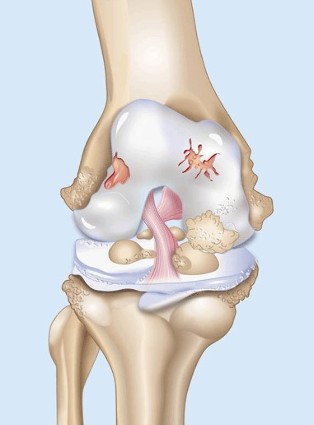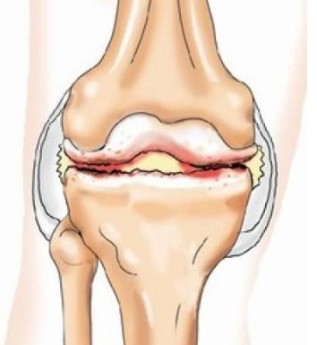Deformation gonarthrosis (arthrosis of knee) is a disease in the hyaline knee cartilage due to inflammatory and degenerative process. This disease encompasses condyle of the tibia and thighs.
Osteoarthritis of the knee joint develops slowly. Main symptoms of this evil – the pain and stiffness. This variation of osteoarthritis, including knee osteoarthritis, is the most common in comparison with other species (arthrosis of phalanges of the fingers, osteoarthritis of the hip, elbow or shoulder arthrosis).
This manifests itself in the disease more often in people of middle age (40 to 45 years), mainly women. The reason for the occurrence of osteoarthritis in young people can constitute the whole of a severe injury or heavy load (for example, athletes).

The causes of osteoarthritis of the knee
The cause of the deformation of the arthrosis of the joints may not be one of the that, generally, it is the totality of the circumstances and of many catalytic factors that over time lead to the appearance of the disease. In the medical causes of the onset of osteoarthritis can be divided into:
- primary;
- secondary.
Primary osteoarthritis develops in older people due to the natural aging process (erase) the cartilage tissues of the body, together with the consequent complications. In the number of complications include problems such as:
- hereditary pathology;
- reinforced by the pressure on the joints in the course of one's life;
- obesity (10% of cases).
The secondary deformavit osteoarthritis take 30% of all cases of the disease in the knee, iuncturam. This form of osteoarthritis develops in the result of the wounds:
- injury to the meniscus;
- the fracture of the tibia;
- rupture of the ligaments;
- strong injury and pain in the knee cup.
The symptoms of secondary osteoarthritis is manifested with a delay – after 3-4 years, but with serious injuries, signs of illness are detected through the 3-4 months.
In the risk group for the development of gonartrosisa includes persons who, after the age of 40 begin to do sport or other physical. Running, squats or pushups give more work worn out the age of the joints. These activities may give rise to a rapid development of degenerative disease and calcification of the processes in the joints.
There are frequent cases of development of osteoarthritis in the soil available to the patient, the comorbidities:
- the disease behtereva;
- rheumatoid, psoriatic or reactive arthritis;
- gout;
- varicose veins;
- excess weight (obesity).
The reasons for the development of deformation directly from the osteoarthritis in the knee joint are:
- regular heavy physical activities;
- the weight lifting;
- frequent elevations of the ladder;
- professionals of the practice of sports;
The risk of receiving a diagnosis, such as osteoarthritis, increases, if the patient is detected lesions the spinal of the division of the bones, of the different neurological diseases, metabolic, diabetes mellitus, and (3-5%) of the cases, the genetic predisposition, due to the weakness of ligamentous apparatus.
Often (50-60%) the development of the deformation of the knee joint arthrosis occurs due to a muscle spasm in the front part of the thigh. A spasm does not manifest itself until the pain in my knees. Drawbacks are the weakness of pain in the lower part of the back, heaviness in the legs and fatigue.
If podvzdoshno-low back and rectus femoris of the thigh are constantly in a state of spasm, with the age of the patient will develop the "contraction" of the knees, which significantly constrain motor function.
The more recent discovery of the scientists
Belgian orthopaedic surgeons of the city of leuven has recently discovered hitherto unknown and absolutely not studied lot of ALL, which is localized in the knee. This ligament has been assigned the name of "antero-lateral" or "anterolaterala".
Research that, after over 4 years, have been confirmed in rare cases, when patients after the celebration of the success of the surgical operation to rupture of the ligaments or injuries of the knee, pain during physical effort not to disappear, and the instability of the knee joint.
In the research participated about 40 of patients, which has allowed the detection of this same branch, on which the doctors are not data in general. As has been elucidated, the main function of the anterolaterala ligaments are the rotational movement of tibial bone.
The trauma of the tribe of the doctors even do not adivinaban on the need for its correction at the time of the surgery.
Classification and deformation of knee osteoarthritis
Often, the disease develops in a single knee. Taking into account the level of development of the pathological processes doctors distinguish 3 degrees of gonartrosisa:
- The first degree of the osteoarthritis of the knee does not imply deformavit changes, however, are present specific newspapers the sensation of pain after the loads at a right angle. Sometimes it takes the slight swelling of the joint, disappearing by itself.
- Osteoarthritis of knee second degree of the symptomatology of the illness worsens considerably. Pain syndrome is already manifesting itself, after a little bit of physical activity. Walk, lift weights, cause longer and more intense pain, the patient receives the badge of the knee crunch. There is likely to be slight deformation of the joint and a small limitation of the movements.
- In the third degree of deformation of the osteoarthritis of the knee joint occurs the maximum disclosure of the symptoms of the disease. The patient alters the gait, pronounced the deformation of the joint and severe functional limitations of movements. The pain increase in function of the climatic conditions, the lack of articulation reaches a maximum at a point. The pain is so severe that the patient is not able to find the position in which they fell, it disturbs the sleep.

With that it can be mistaken for osteoarthritis of the knee joint?
There are several diseases similar in their symptoms with knee osteoarthritis):
The knee locking and the locking of the menisci. This disease develops quickly. The sharp movement is produced a crunch in the knee accompanied by acute exacerbation of the pain, that passes through, 10-15 minutes. After that, the night is caused by inflammation of the patella.
The different types of arthritis (rheumatoid, psoriatic, reactive), the articular rheumatism, the disease behtereva, gout. To distinguish these diseases, from osteoarthritis by means of a blood test.
The inflammation of the tendons of the knee. This disease mainly affects women after the age of 40. The pain occur when you lift weights or stair descent. The pain covers the inner surface of the knee, but the functionality of the joint is not limited.
Cardiovascular diseases pain in the knees. Is symmetric, the defeat of joints, which includes the two knees at the same time. Occurs mainly in the younger generations due to the acceleration of the growth of the bones. Pain syndrome, points out that:
- when the weather conditions change;
- to diseases of cold;
- when performing a physical effort.
It is defined as pain (twisting).
The symptoms are deformation of knee osteoarthritis phase
In the first phase hit the knee of the external symptoms is not anything healthy.
- Sometimes, in the area of the defeat can be seen a slight swelling.
- In the rare cases in iuncturam observed the accumulation of fluids, and is highly swollen, taking the form esfrica.
- Develops synovitis.
- It limits the functionality of the joint.
- There is a sense of gravity.
This is due to?
During the initial stage of development of osteoarthritis in the joint produces a violation of the small in the interior-the bones of the blood vessels and the circulation of the blood in general, depend on the power of hyaline cartilage.
For the development of the disease (second stage), the symptoms intensifies. The pain is defined in the antero-internal part of the joint, and annoying even when not large loads, retreating in the resting state and returning to the slightest movement.
When deforming arthrosis of the knee joint of third grade, there is a considerable deformation joint of the bones. Are inserted inside of itself, the cartilage fabric almost totally destroyed, the increasing scarcity. Syndrome pain goes not backward nor a minute, regardless of the voltage or the state of rest, in which is located the joint. Flexion and extension of the limb difficult.
The joint is strongly distorted, the legs are bent in the On - or X - form of i, the walk becomes unstable. Very often the patient has to move with the aid of crutches or canes.































